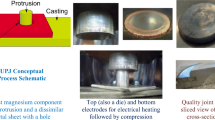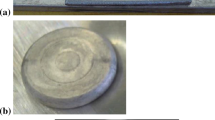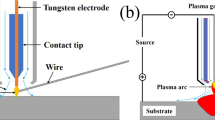Abstract
Magnesium alloys have a significant benefit over the steel and aluminum alloys in manufacturing of components for many automotive and structural applications because of their extreme lightweight, low density, and high strength to weight ratio. However, one of the glaring impediments to the success of steels, aluminum, and magnesium-based multi-material integration for automotive industries is the ability to join these materials together without any cracking and corrosive damages during a performance. The present work aims to demonstrate a cost-effective, novel, and versatile joining technique, named Upset Protrusion Joining (UPJ), to mechanically and rapidly (1–2 s) join die-cast AM60 alloy to aluminum alloy sheet and evaluate its UPJ characteristics. Cast Mg plate has a cylindrical protrusion (11 mm diameter and 14 mm height) emanated perpendicular to its flat surface, and an aluminum sheet has a hole that accommodates the protrusion. Mg and Al alloy components are then clamped together, electrically heated, and compressed perpendicular to the protrusion axis. During compression, the protrusion expanded circumferentially to fill the hole as well as the region above the hole, and entrapped the Al sheet between the deformed (in a mushroom shape) head and the Mg plate. The effect of different UPJ process parameters such as applied current, current duration, compression loading rate, and compression distance is studied. The process demonstrated repeatability at given process conditions, and optimum process parameters were identified that produce visibly good joints (defect-free) and sufficient joint strengths when tested in the lap-shear mode under uniaxial tension. AM60 alloy showed a great promise as a candidate alloy to suit the UPJ method to adapt to automotive and other industrial manufacturing units to join with dissimilar wrought Al alloy sheets.
















Similar content being viewed by others
Data availability
The raw and processed data required to reproduce the present work’s findings cannot be shared at this time as the data also forms part of an ongoing study. Some data is available upon request.
References
Kainer KU, Dieringa H, Dietzel W, Hort N, Blawert C (2006) The use of magnesium alloys: Past, present and future. In Magnesium Technology in the Global Age, Proceedings of the International Symposium on Magnesium Technology in the Global Age, Montreal, QC, Canada, 1–4 October 2006; (Eds.) M.O. Pekguleryuz, L.W.F. Mackenzie; Canadian Institute of Mining, Metallurgy and Petroleum: Montreal, QC, Canada, pp 3–19
Luo AA (2004) Recent magnesium alloy development for elevated temperature applications. Inter Mater Rev 49:13–30. https://doi.org/10.1179/095066004225010497
Schubert E, Klassen M, Zerner I, Walz C, Sepold G (2001) Light-weight structures produced by laser beam joining for future applications in automobile and aerospace industry. J Mater Process Technol 115:2–8. https://doi.org/10.1016/S0924-0136(01)00756-7
Cam G, Kocak M (1998) Progress in joining of advanced materials. Int Mater Rev 43:1–44. https://doi.org/10.1179/imr.1998.43.1.1
Cole GS, Sherman AM (1995) Light weight materials for automotive applications. Mater Charact 35:3–9. https://doi.org/10.1016/1044-5803(95)00063-1
Shah LH, Ishak M (2014) Review of research progress on aluminum-steel dissimilar welding. Mater Manuf Processes 29:928–933. https://doi.org/10.1080/10426914.2014.880461
Dharmendra C, Rao KP, Wilden J, Reich S (2011) Study on laser welding-brazing of zinc coated steel to aluminum alloy with a zinc based filler. Mater Sci Eng A 528:1497–1503. https://doi.org/10.1016/j.msea.2010.10.050
Scherm F, Bezold J, Glatzel U (2012) Laser welding of Mg alloy MgAl3Zn1 (AZ31) to Al alloy AlMg3 (AA5754) using ZnAl filler material. Sci Technol Weld Join 17:364–367. https://doi.org/10.1179/136217112X13333824902080
Liu F, Zhang ZD, Liu LM (2012) Microstructure evolution of Al/Mg butt joints welded by gas tungsten arc with Zn filler metal. Mater Charact 69:84–89. https://doi.org/10.1016/j.matchar.2012.04.012
Gao M, Mei S, Li X, Zeng X (2012) Characterization and formation mechanism of laser-welded Mg and Al alloys using Ti interlayer. Scr Mater 67:193–196. https://doi.org/10.1016/j.scriptamat.2012.04.015
Firouzdor V, Kou S (2010) Al-to-Mg friction stir welding: effect of material position, travel speed, and rotation speed. Metall Mater Trans A 41:2914–2935. https://doi.org/10.1007/s11661-010-0340-1
Somasekharan AC, Murr LE (2004) Microstructures in friction-stir welded dissimilar magnesium alloys and magnesium alloys to 6061–T6 aluminum alloy. Mater Charact 52:49–64. https://doi.org/10.1016/j.matchar.2004.03.005
Firouzdor V, Kou S (2010) Formation of liquid and intermetallics in Al-to-Mg friction stir welding. Metall Mater Trans A 41:3238–3251. https://doi.org/10.1007/s11661-010-0366-4
Sato YS, Shiota A, Kokawa H, Okamoto K, Yang Q, Kim C (2010) Effect of interfacial microstructure on lap shear strength of friction stir spot weld of aluminium alloy to magnesium. Sci Technol Weld Join 15:319–324. https://doi.org/10.1179/136217109X12568132624208
Fernandus MJ, Senthilkumar T, Balasubramanian V, Rajakumar S (2012) Optimizing diffusion bonding parameters in AA6061-T6 aluminum and AZ80 magnesium alloy dissimilar joints. J Mater Eng Perform 21:2303–2315. https://doi.org/10.1007/s11665-012-0190-7
Dietrich D, Nickel D, Krause M, Lampke T, Coleman MP, Randle V (2011) Formation of intermetallic phases in diffusion-welded joints of aluminium and magnesium alloys. J Mater Sci 46:357–364. https://doi.org/10.1007/s10853-010-4841-5
Liu LM, Zhao LM, Xu RZ (2009) Effect of interlayer composition on the microstructure and strength of diffusion bonded Mg/Al joint. Mater Des 30:4548–4551. https://doi.org/10.1016/j.matdes.2009.04.040
Zhao LM, Zhang ZD (2008) Effect of Zn alloy interlayer on interface microstructure and strength of diffusion-bonded Mg-Al joints. Scr Mater 58:283–286. https://doi.org/10.1016/j.scriptamat.2007.10.006
Zhang J, Luo G, Wang Y, Shen Q, Zhang L (2012) An investigation on diffusion bonding of aluminum and magnesium using a Ni interlayer. Mater Lett 83:189–191. https://doi.org/10.1016/j.matlet.2012.06.014
Darwish SMH, Ghanya A (2000) Critical assessment of weld-bonded technologies. J Mater Process Technol 105:221–229. https://doi.org/10.1016/S0924-0136(00)00592-6
Chang B, Shi Y, Lu L (2001) Studies on the stress distribution and fatigue behavior of weld-bonded lap shear joints. J Mater Process Technol 108:307–313. https://doi.org/10.1016/S0924-0136(00)00842-6
Logan SD, Langer DM (2012) Upset Protrusion Joining. US Patent US 2012/0210558 A1
Andreae N, Dharmendra C, Jain MK (2021) Development of a laboratory-scale Upset Protrusion Joining (UPJ) system for dissimilar materials. Int J Adv Manuf Tech 113:2725–2738. https://doi.org/10.1007/s00170-021-06826-9
Buch A (1999) ASM Specialty Handbook – Magnesium and Magnesium Alloys. ASM International, Metals Park, OH. pp 22–49
Mucha J, Kaščák L, Spišák E (2011) Joining the car-body sheets using clinching process with various thickness and mechanical property arrangements. Arch Civ Mech Eng 11:135–148. https://doi.org/10.1016/S1644-9665(12)60179-4
Logothetis N, Wynn HP (1990) Quality Through Design: Experimental Design, Off-line Quality control, and Taguchi’s Contributions. Oxford University Press, Oxford Science Publications. https://doi.org/10.1002/qre.4680060217
Kula A, Tokarski T, Niewczas M (2019) Comparative studies on the structure and properties of rapidly solidified and conventionally cast AM60 magnesium alloys. Mater Sci Eng A 759:346–356. https://doi.org/10.1016/j.msea.2019.05.044
Yan C, Xin Y, Wang C, Liu H, Liu Q (2020) Microstructure and texture evolution of the β-Mg17Al12 phase in a Mg alloy with an ultra-high Al content. J Mater Sci Tech 52:89–99. https://doi.org/10.1016/j.jmst.2020.04.021
Zhang Y, Zheng J, Shou H, Li J, Wan L, Han W, Liu Q, Xia L (2020) The gradient microstructure and deformation heterogeneity in HPDC AM60 alloy. Mater Sci Eng A 792:139647. https://doi.org/10.1016/j.msea.2020.139647
Dharmendra C, Rao KP, Prasad YVRK, Hort N, Kainer KU (2012) Hot working mechanisms and texture development in Mg-3Sn-2Ca-0.4Al alloy. Mater Chem Phys 136:1081–1091. https://doi.org/10.1016/j.matchemphys.2012.08.054
Dharmendra C, Jain MK, Shankar S, Fazeli F (2019) Workability characteristics and deformation mechanisms of die-cast AM60 and AZ91 magnesium alloys: Correlation with processing maps. J Mater Engg Perf 28:123–139. https://doi.org/10.1007/s11665-018-3745-4
Luo AA, Zhang C, Sachdev AK (2012) Effect of eutectic temperature on the extrudability of magnesium-aluminum alloys. Scr Mater 66:491–494. https://doi.org/10.1016/j.scriptamat.2011.12.025
Acknowledgements
The authors are grateful to Dr. Sumanth Shankar of McMaster University and Mr. Steve Logan of Fiat Chrysler Automotive (FCA) for their technical support and many discussions. The authors would also like to acknowledge the technical support Mr. Ron Lodewyks, Mr. Clealand Berwick, Mr. Joe Verhaeghe, Mr. Michal Lee, Mr. John Colenbrander, and Mr. Mark MacKenzie, all part of Faculty of Engineering at McMaster University, in the design and development of UPJ system.
Funding
This research was carried out and financially supported under the Automotive Partnership Canada (APC) program of Natural Science and Engineering Research Council (NSERC) of Canada with Dr. Sumanth Shankar of Department of Mechanical Engineering, McMaster University, as Principal Investigator.
Author information
Authors and Affiliations
Contributions
N. Andreae: conceptualization; visualization; data curation; formal analysis; investigation; methodology; software; validation; writing—original draft. C. Dharmendra: investigation; writing—original draft. M.K. Jain: conceptualization; visualization; investigation; methodology; project administration; resources; supervision; writing—review and editing.
Corresponding author
Ethics declarations
Ethics approval
This article contains research, which is original, is unpublished, and has neither previously nor simultaneously been submitted anywhere else. It is not being submitted to any other journal as well.
Consent to participate
Not applicable.
Consent for publication
Not applicable.
Competing interests
The authors declare no competing interests.
Additional information
Publisher's Note
Springer Nature remains neutral with regard to jurisdictional claims in published maps and institutional affiliations.
Rights and permissions
About this article
Cite this article
Andreae, N., Chalasani, D. & Jain, M. Upset Protrusion Joining (UPJ) characteristics of cast AM60 magnesium alloy to join with dissimilar material. Int J Adv Manuf Technol 120, 329–348 (2022). https://doi.org/10.1007/s00170-021-08563-5
Received:
Accepted:
Published:
Issue Date:
DOI: https://doi.org/10.1007/s00170-021-08563-5




